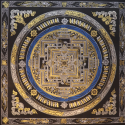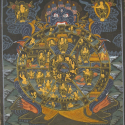Description
Sahasrabhuja Avalokiteswara with Green Tara Thangka is handpainted on cotton canvas by a Thangka artist from Nepal. The size of this thangka is 61 x 45mand its weight is 0.1kg. Avalokiteswara is also known as Chenrezig.
Sahasrabhuja Avalokitesvara is presented at the center of the thangka. Vajrapani is presented at the bottom right corner of the Sahasrabhuja Avalokitesvara in the thangka. Manjushree is presented at the bottom left corner of the Sahasrabhuja Avalokitesvara in the thangka.
Green Tara is presented at the top-right corner of the Sahasrabhuja Avalokitesvara in the thangka. Shakyamuni Buddha is presented at the top of Sahasrabhuja Avalokitesvara in the thangka. White Tara is presented at the top left corner of the Sahasrabhuja Avalokitesvara in the thangka. Chenrezig is the most revered of all Bodhisattva.
He is the lord gifted with complete enlightenment who refrains from entering the blissful state of nirvana to remain here below and save the living being of the earth.
Iconography of Sahasrabhuja Avalokitesvara
Chenrezig is visualized in many forms with various numbers of faces and arms, and various colors and ornaments. He sits on a lotus and the flat disc of the moon with another moon disk behind him, reflecting his total purity. Two of his four arms are joined in the prayer position holding the wish-fulfilling gem.
Mantra of Sahasrabhuja Avalokitesvara
The Mantra of Sahasrabhuja Avalokitesvara is Om Mani Padme Hum.
Iconography of Vajrapani
Vajrapani is presented at the bottom right corner of the Sahasrabhuja Avalokitesvara in the thangka. Vajrapaṇi is one of the earliest bodhisattvas of Mahayana Buddhism. He is the protector and guide of the Buddha and rose to symbolize the Buddha’s power.
Vajrapani is pictured dancing wildly within a halo of flames which represents transformation. He holds a vajra (thunderbolt) in his right hand which emphasizes the power to cut through the darkness of delusion. Vajrapani looks wrathful, but as a representation of the enlightened mind. He is completely free from hatred.
Mantra of Vajrapani
The mantra of Vajrapani is om vajrapani hum phat.
Iconography of Manjushree
Manjushree is presented at the bottom left corner of the Sahasrabhuja Avalokitesvara in the thangka. Manjushree is the Bodhisattva who holds the flaming sword of enlightenment, by his left hand in a warning hand gesture in the left hand representing his realization of wisdom to cut through ignorance & wrong view. His right hand depicted in teaching holds the stem of a Blue Lotus flower upon which rests the Book (Pustaka) of Perfection of Transcendental Wisdom.
Mantra of Manjushree
The mantra of Manjushree is Om A Ra Pa Ca Na Dhih.
Iconography of Green Tara
Green Tara is presented at the top-right corner of the Sahasrabhuja Avalokitesvara in the thangka. Green Tara is also known as Samaya Tara. She is represented in a royal ease posture with her left leg bent her left leg overstepping the main lotus and resting on a blue lotus ready to get up and offer assistance to those in need.
She is portrayed with maroon Buddhist robes and jewelry. The earrings represent patience, understanding, and renunciation. The diadem with five jewels represents the transmutation of the five delusions into the Five Buddha Wisdoms. She is shown with a benevolent countenance seated upon a white moon disk which is associated with special restorative nectar associated with the naval chakra center.
Mantra of Green Tara
The mantra of Green Tara is om tare tuttare ture soha.
Iconography of White Tara
White Tara is presented at the top-left corner of the Sahasrabhuja Avalokitesvara in the thangka. White Tara’s embodiment of peace is directed through loving compassion. From her serenity, she lends grace and dignity to situations and encourages the good to arise in all circumstances and situations.
The extra eye on her forehead, on the palms of her hands & the soles of her feet, represent her ability to see and understand the sufferings of all beings & her omniscient compassion toward the suffering.
Mantra of White Tara
The mantra of White Tara is Om Tare Tuttare Ture Mama Ayur Pune Gyana Puntin Kuru Swoha.
Iconograpy of Shakyamuni
His left hand is in the lap holding a begging bowl while the right arm is extended across the leg with the fingers touching the earth.
His skin is golden in color, the eyes partially closed and the hair piled with a gold ornament adorning the top of the head.
A dot (bindi or “urna”) between the eyebrows and the earlobes are elongated and pierced. The shoulders are covered with an orange and red robe wrapped around the torso and legs and tied at the waist with a green sash.
Mantra of Shakyamuni
The mantra of Shakyamuni is Om Muni Muni Maha Muniye Soha.








































Reviews
There are no reviews yet.